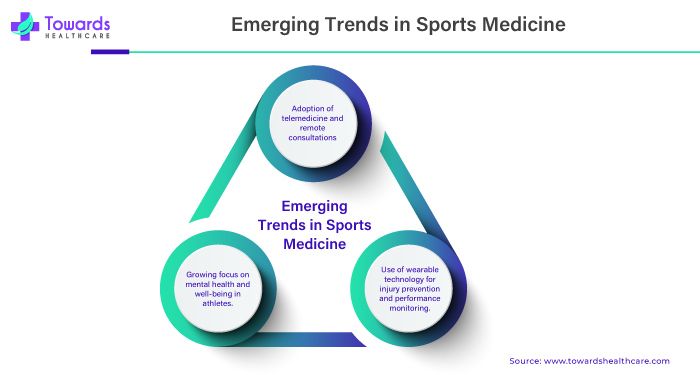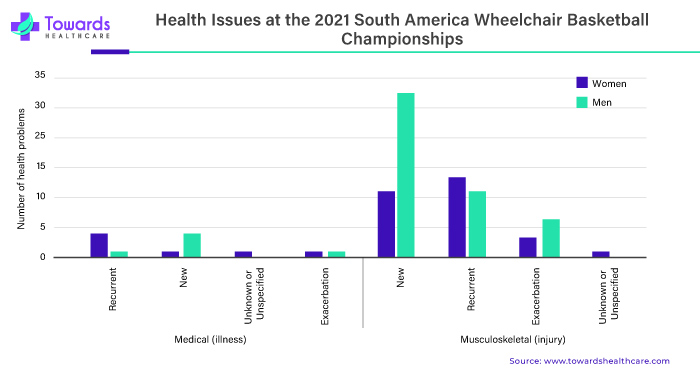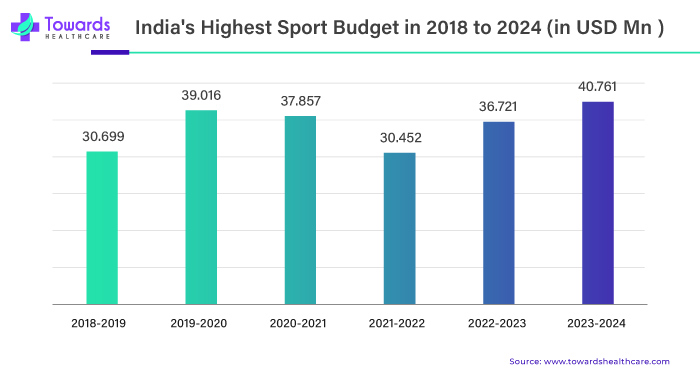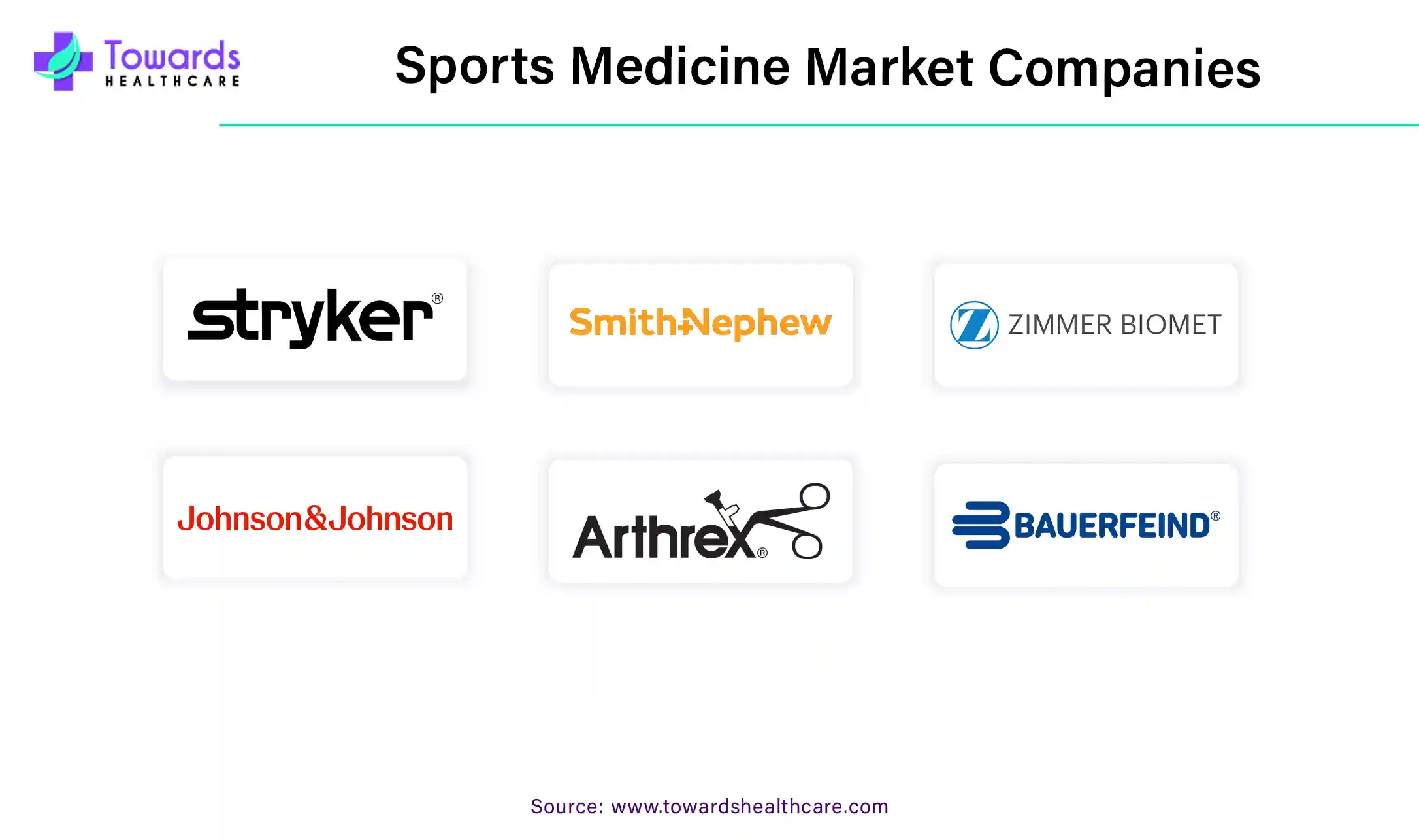December 2025

The sports medicine market is anticipated to grow from USD 6.69 billion in 2025 to USD 11.90 billion by 2034, with a compound annual growth rate (CAGR) of 6.6% during the forecast period from 2025 to 2034.

As per John Hopkin Medicine reports, every year, more than 3.5 million kids under 14 get hurt playing sports or having fun; over 775,000 kids in this age group go to the emergency room because of sports-related injuries. Due to the high number of injuries in sports, there's been an increase in innovation in sports medicine.
The sports medicine market is a multifaceted realm dedicated to the well-being and performance of athletes. Its scope extends beyond mere injury treatment, encompassing a proactive approach to prevention. Specialists in sports medicine focus on developing strategies to safeguard athletes during training and competition, aiming to mitigate the risk of injuries. In the event of injuries, a collaborative team of critical players emerges. Physicians and orthopedic surgeons, armed with expertise in sports medicine, diagnose and treat sports-related injuries, with orthopedic surgeons handling more severe cases requiring surgical intervention. Physical therapists play a pivotal role in rehabilitation, designing personalized programs to facilitate a speedy and effective return to play. Additionally, sports trainers and coaches contribute significantly by actively preventing injury, providing immediate care, and guiding athletes through recovery.
At the Winter Olympic Games in Beijing 2022, the medical team noted 725 injuries and 1,119 illnesses while evaluating 35,537 athletes and non-athletes. That means there were about 24 injuries and 31 illnesses for every 1000 athletes and non-athletes. In simpler terms, 2.4% of the participants got hurt, and 3.1% fell ill at least once. This suggests that many athletes dealing with injuries might be a reason for the growth of the sports medicine market. Technological advancements heavily influence the sports medicine landscape. Diagnostic tools such as MRI and CT scans enable precise injury diagnosis, while rehabilitation benefits from advanced equipment that aids in targeted exercises and recovery. Wearable technology including fitness trackers and bright clothing, further enhances the monitoring of athletes' performance and health.
Pharmaceuticals and therapeutics constitute another crucial aspect of sports medicine. Specialized medications are prescribed for pain management, inflammation reduction, and muscle recovery. Additionally, regenerative medicine techniques like stem cell therapy and platelet-rich plasma (PRP) are gaining prominence for their potential in promoting healing. Global market trends underscore the increasing demand for sports medicine services, propelled by a rising engagement in sports and fitness activities. Investments in research and development drive continuous innovation, leading to the emergence of novel treatments, technologies, and rehabilitation methods. The integration of telemedicine is on the rise, providing athletes with remote consultations and monitoring and enhancing accessibility to sports medicine expertise.
Furthermore, the field of sports medicine faces challenges. The cost of accessing advanced services can be a barrier, particularly for amateur athletes. Moreover, an injury stigma persists, causing some athletes to delay seeking help out of fear of being sidelined or perceived as weak, thereby complicating the treatment process. The sports medicine market is a dynamic and evolving domain that harmonizes medical expertise, innovative technology, and a profound understanding of the physical demands of sports. Beyond addressing injuries, its ultimate goal is to empower athletes to pursue their passions with optimal health and performance.
Sports medicine healthcare providers are specially trained to help injured individuals get back on their feet as quickly as possible. They excel in preventing injuries and illnesses in active people. While they do work with professional athletes, their expertise extends to children and teens in sports, adults maintaining personal fitness, and even those in physically demanding jobs, like construction.
Sports medicine isn't a standalone medical specialty. Instead, most providers are certified in other areas, such as internal medicine, emergency medicine, family medicine, or pediatrics, before undergoing additional training in sports medicine. Pediatric sports medicine specialists focus on the unique needs of growing bodies and are typically board-certified in pediatrics or family medicine with further sports medicine training. Some sports medicine professionals also have surgical training, often as orthopedic surgeons.
In addition to medical doctors, sports medicine care teams often include:
Together, these experts work to ensure that everyone, from athletes to everyday workers, can stay active and healthy.

As our world becomes more connected and information spreads, people from around the globe are discovering the joy of sports and staying active. It's not just about watching games on TV; folks want to get out there, play, and experience the thrill firsthand. Whether it's soccer in South America, running in Europe, or basketball in Asia, sports have become a universal language that brings people together.
For Instance,
With this surge in global sports enthusiasm, there's a greater awareness of the importance of caring for our bodies to keep up with the pace. That's where sports medicine steps in, acting as the guardian angel for all those eager athletes. Imagine you're a soccer player in Brazil or a runner in Japan – you want to give your best, but sometimes you might need a little help recovering from an injury or preventing one in the first place. That's where sports medicine professionals become your teammates, offering advice, treatments, and strategies to keep you playing and loving every moment on the field or track.
The cool part is that advancements in medicine play a significant role in this global sports boom. Imagine a time when treatments are more effective, recovery is faster, and you have access to cutting-edge technologies that understand your body's needs. This innovation in sports medicine makes people more confident to join in, knowing that a team of experts is ready to assist if they ever face a hiccup.
For Instance,
More global interest in sports leads to more people wanting to play, and as they play, they realize the importance of sports medicine in keeping them in the game. As medicine advances and becomes more innovative, it becomes a driving force encouraging even more people to join the sports craze. It's a win-win – a world where everyone can be active in the game, supported by the fantastic strides in sports medicine innovation!
According to the John Hopkins Medicines, every year, over 3.5 million kids aged 14 and younger get injured while playing sports or having fun. Almost half of the head injuries happen during activities like biking, skateboarding, or skating. More than 775,000 kids in this age group end up in the emergency room because of sports-related injuries. Most of these injuries happen from falls, getting hit by something, collisions, or pushing too hard during informal sports. Because more injuries are happening, it's essential to have the right medicines to help with the pain and healing. Imagine you're an athlete, whether sprinting down a soccer field, conquering marathon miles, or hitting the gym regularly. Your body goes through a lot – the excitement of competition, the strain of workouts, and, sometimes, the less enjoyable part – injuries. In this athletic journey, sports medicine acts like your superhero team, focusing on two crucial aspects: providing essential support and aiding recovery.
For Instance,

| Sport Classification |
Injuries n=93 n(%) |
Illnesses n=15 n(%) |
Women n=44 n(%) |
Men n=64 n(%) |
Total n=108 n(%) |
Health Problems/100 Athletes n = 108 |
Injuries/1,000 athlete-h n = 43 IR (CI del 95%) |
| 1.0 (n = 24) | 15 (13.9) | 2(1.9) | 9 (20.5) | 8 (12.5) | 17 (15.7) | 70.8 (37.2-104.5) | 7.6 (1.5-13.6) |
| 1.5 (n=7) | 5 (4.6) | 2(1.9) | 1 (2.3) | 6 (9.4) | 7 (6.5) | 100.0 (25.9-174.1) | 20.3 (2.5-38.0) |
| 2.0 (n=17) | 13 (12.0) | 2(1.9) | 10 (22.7) | 5 (7.8) | 15 (13.9) | 88.2 (43.6-132.9) | 9.1 (1.1-17.2) |
| 2.5 (n = 16) | 15 (13.9) | 1 (0.9) | 3 (6.8) | 13 (20.3) | 16 (14.8) | 1000 (51.0-149.0) | 17.1 (5.3-29.0) |
| 3.0 (n = 14) | 8 (7.4) | 2 (1.9) | 2 (4.5) | 8 (12.5) | 10 (9.3) | 71.4 (27.2-115.7) | 4.9 (0.0-11.7) |
| 3.5 (n = 10) | 5 (4.6) | 1 (0.9) | 2 (4.5) | 4 (6.3) | 6 (5.6) | 60.0 (12.0-108.0) | 2.9 (0.0-8.7) |
| 4.0 (n = 27) | 18 (16.7) | 4 (3.7) | 9 (20.5) | 13 (20.3) | 22 (20.4) | 107.1 (52.9-161.4) | 81.5 (47.4-115.5) |
| 4.5 (n=14) | 14 (13.0) | 1 (0.9) | 8 (18.2) | 7 (10.9) | 15 (13.9) | 16.7 (4.3-13.6) | 10.2 (3.5-16.9) |
C1 95% 95% confidence interval; IR injury rate
Maintaining your body in prime condition is crucial in the dynamic realm of sports. Sports medicine doesn't just step in when something goes wrong; it is a constant support system. This involves expert guidance on injury prevention, tips on proper training techniques, and recommendations for gear or braces to shield vulnerable areas. It's like having a personal coach ensuring your body performs at its best, minimizing the risk of injuries. Now, let's talk about the magic of recovery. Whether it's after an intense game or a demanding workout, your body needs to bounce back. Sports medicine comes with various techniques – from personalized rehabilitation exercises to innovative treatments like massages or ice baths. These strategies are like a superhero's healing potion, specifically designed to accelerate your body's recovery, allowing you to get back into action swiftly.
Imagine having devices that monitor your body's performance in real-time or using innovative equipment for rehabilitation. These innovations make the entire process more efficient, ensuring you spend less time on the sidelines and more time doing what you love. This superhero team is even more incredible because it's not reserved for the pros. Sports medicine is becoming increasingly accessible to everyone, from weekend warriors to aspiring young athletes. You don't have to be a superstar to reap the benefits. Whether you're aiming for the Olympics or to stay active, a comprehensive range of support and recovery options are available.
The rising market for sports medicine is akin to having a dedicated players team committed to keeping your body strong, resilient, and ready for action. It goes beyond fixing things when they go wrong; it's about providing unwavering support every step of the way, ensuring you can relish your favorite activities without undue worry about bumps and bruises.
Think of sports medicine as having a unique team of experts who can keep athletes in great shape and help them recover from injuries. Imagine you want to be part of this team, but there's a catch – it can be a bit pricey. The tools and technologies used in sports medicine, like advanced treatments and fancy equipment, can be expensive. So, if you're someone who doesn't have a lot of money to spare, accessing these top-notch services might feel like a bit of a challenge. It creates a situation where not everyone can quickly join the game. Imagine you're a talented athlete in a country where high-quality sports medicine services are expensive. It might feel like these services are reserved for the lucky few who can afford them.
This cost barrier is like having a gate that only opens for those with a certain amount of money. It means that even if fantastic sports medicine services exist, only some benefit from them. This can slow the growth of the sports medicine market globally because it's reaching fewer people than possible. The cost barrier is like a roadblock that makes it harder for everyone, regardless of their income, to access sports medicine's fantastic support and recovery options. Ideally, we'd want this superhero team of sports medicine to be available to as many people as possible, ensuring everyone can play their favorite sports confidently and with care, no matter their financial situation.
For Instance,
The geographical landscape of sports medicine in North America is diverse and characterized by advanced healthcare infrastructure, a robust sports culture, and a high level of awareness regarding the importance of sports-related health and wellness. North America boasts a well-developed network of medical facilities and specialized sports medicine centers. Major cities and metropolitan areas have state-of-the-art clinics, hospitals, and rehabilitation centers that cater specifically to athletes and sports enthusiasts. Professional associations, such as the American College of Sports Medicine (ACSM) and the American Orthopaedic Society for Sports Medicine (AOSSM), foster collaboration among healthcare professionals. These associations contribute to the standardization and advancement of sports medicine practices. The geographical landscape of sports medicine in North America reflects a blend of advanced healthcare infrastructure, a vibrant sports culture, and a commitment to research and education.
U.S. Market Trends
The increasing awareness of sports participation and the rising number of sports medicine centers drive the market in the U.S. There are around 46 active sports medicine physician group practices in the U.S. Executive Order 14109 renewed the President’s Council on Sports, Fitness & Nutrition until September 30, 2025.
Canada Market Trends
The Government of Canada actively promotes participation in sports through initiatives and investments. Sport Canada enhances opportunities for Canadians to participate and excel in sports through policy leadership and strategic investments.
The geographical landscape of sports medicine in the United Kingdom (U.K.) showcases a well-established framework that combines a rich sporting tradition, advanced healthcare facilities, and a commitment to research and education. The U.K.'s National Health Service (NHS) provides sports medicine services significantly. Many sports medicine professionals work within the NHS, ensuring that many individuals, including amateur and professional athletes, can access healthcare support. A blend of specialized healthcare facilities, academic excellence, and collaboration with professional sports entities characterizes the U.K.'s sports medicine landscape.

The Asia-Pacific region is experiencing a surge in sports participation and interest, driven by urbanization, changing lifestyles, and the influence of international sports events. This rising sports culture contributes to the demand for sports medicine services. Diverse cultural sports practices, such as martial arts, cricket, and traditional Asian games, contribute to a varied sports medicine landscape. Professionals in the field must adapt their expertise to cater to the specific needs of athletes in different sports.
China Market Trends
According to a recent survey by the National Bureau of Statistics, Chinese residents have seen an increase in participation in physical activity, with a participation rate of 49.6% in sports and exercise. The Chinese government also actively promotes the “integration of sports and medicine” (ISM) under the “Healthy China 2030” strategy.
India Market Trends
The Pandit Deendayal Upadhyay National Welfare Fund for Sportspersons, by the Indian government, offers a monthly pension of Rs 5,000, medical assistance up to Rs 10 lakh, and up to Rs 10 lakh for injuries sustained during sports training or competitions.
The competitive landscape for the sports medicine market is dynamic, characterized by the presence of established companies, emerging players, and continuous innovations. Companies use mergers, acquisitions, and partnerships to expand their product portfolios and geographic reach. For example, acquisitions of smaller firms with innovative technologies allow larger companies to strengthen their position and enhance their offering. Continuous innovation in developing sports medicine products is critical to the competitive landscape. Companies invest in research and development to introduce advanced technologies, implants, and devices to prevent, diagnose, and treat sports-related injuries. The competitive landscape in sports medicine is influenced by the ability of companies to innovate, collaborate, and adapt to the evolving needs of athletes and healthcare professionals. As the market grows, strategic moves and technological advancements will play crucial roles in shaping the competitive dynamics.

By Product
By Injury Type
By End User
By Geography
December 2025
October 2025
October 2025
November 2025